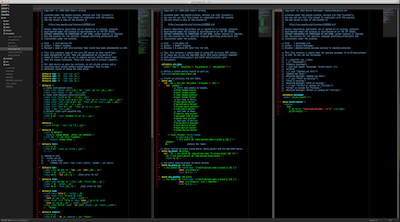LFE
LFE Support in Sublime Text
Labels language syntax
Details
Installs
- Total 295
- Win 69
- Mac 142
- Linux 84
| Nov 22 | Nov 21 | Nov 20 | Nov 19 | Nov 18 | Nov 17 | Nov 16 | Nov 15 | Nov 14 | Nov 13 | Nov 12 | Nov 11 | Nov 10 | Nov 9 | Nov 8 | Nov 7 | Nov 6 | Nov 5 | Nov 4 | Nov 3 | Nov 2 | Nov 1 | Oct 31 | Oct 30 | Oct 29 | Oct 28 | Oct 27 | Oct 26 | Oct 25 | Oct 24 | Oct 23 | Oct 22 | Oct 21 | Oct 20 | Oct 19 | Oct 18 | Oct 17 | Oct 16 | Oct 15 | Oct 14 | Oct 13 | Oct 12 | Oct 11 | Oct 10 | Oct 9 | |
|---|---|---|---|---|---|---|---|---|---|---|---|---|---|---|---|---|---|---|---|---|---|---|---|---|---|---|---|---|---|---|---|---|---|---|---|---|---|---|---|---|---|---|---|---|---|
| Windows | 0 | 0 | 0 | 0 | 0 | 0 | 0 | 0 | 0 | 0 | 0 | 0 | 0 | 2 | 0 | 0 | 0 | 0 | 0 | 0 | 0 | 0 | 0 | 0 | 0 | 0 | 0 | 0 | 0 | 0 | 0 | 1 | 0 | 0 | 0 | 0 | 0 | 1 | 0 | 0 | 0 | 0 | 0 | 0 | 0 |
| Mac | 0 | 0 | 0 | 0 | 0 | 0 | 0 | 0 | 0 | 0 | 0 | 0 | 0 | 0 | 0 | 0 | 0 | 0 | 0 | 0 | 0 | 0 | 0 | 0 | 0 | 0 | 0 | 0 | 0 | 0 | 0 | 0 | 0 | 0 | 0 | 0 | 0 | 0 | 0 | 0 | 0 | 0 | 0 | 0 | 0 |
| Linux | 0 | 0 | 0 | 0 | 0 | 0 | 0 | 0 | 0 | 0 | 0 | 0 | 0 | 0 | 0 | 0 | 0 | 0 | 0 | 0 | 0 | 0 | 0 | 0 | 0 | 0 | 0 | 0 | 0 | 0 | 0 | 0 | 0 | 0 | 0 | 0 | 0 | 0 | 0 | 0 | 0 | 0 | 0 | 0 | 2 |
Readme
- Source
- raw.githubusercontent.com
Sublime Text Plugin for LFE (Lisp Flavored Erlang)
This Sublime Text package provides support for syntax highlighting of LFE and is intended to be installed via Package Control.
If you would like to use the stand-alone package and install it manually, visit the other project home.
Installation
In a terminal:
$ mkdir -p ~/lab/SublimeText $ cd ~/lab/SublimeText $ git clone https://github.com/lfex/sublime-lfe.git $ cd ~/Library/Application\ Support/Sublime\ Text\ 2/Packages/ $ ln -s ~/lab/SublimeText/sublime-lfe/LFE .
Configuration
If you would like to dim the parenthesis down visually, you can use the VimBlackboard Sublime Text package. This will give you a look such as this:

If you'd just like to continue using your own theme, you can update it to use dimmed parens with the following snippet:
<dict> <key>name</key> <string>Lisp Parens</string> <key>scope</key> <string>source.parens.lfe</string> <key>settings</key> <dict> <key>foreground</key> <string>#666666</string> </dict> </dict>
